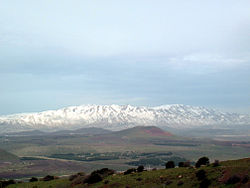Since 1981, the area has been governed under the Golan Heights Law |
Viewfinder (talk | contribs) Israeli occupation and annexation is not internationally recognised |
||
| Line 1: | Line 1: | ||
[[Image:Hermonsnow.jpg|thumb|right|250px|Mount Hermon]] |
[[Image:Hermonsnow.jpg|thumb|right|250px|Mount Hermon]] |
||
'''Mount Hermon''' ([[Arabic language|Arabic]]: '''Jabal El-Sheikh''', '''Djabl A-Sheikh''' [[Hebrew language|Hebrew]]: '''חרמון''') is a [[mountain]] in the [[Anti-Lebanon]] range, on the border between [[Lebanon]] |
'''Mount Hermon''' ([[Arabic language|Arabic]]: '''Jabal El-Sheikh''', '''Djabl A-Sheikh''' [[Hebrew language|Hebrew]]: '''חרמון''') is a [[mountain]] in the [[Anti-Lebanon]] range, on the border between [[Lebanon]] and [[Syria]]. At 2,814 metres (9,230 feet) above [[sea level]], it is the highest mountain in [[Syria]]. The southern and western slopes of Mount Hermon and the [[Golan Heights]] to the [[South]] came under the control of [[Israel]] on [[June 10]] [[1967]] as a result of the [[Six Day War]]. Since [[1981]], the area has been governed under the [[Golan Heights Law]]. Mount Hermon serves as Israel's only ski resort with a wide range of ski trails for the novice, intermediate and expert skier. It also offers additional winter family activities such as sleigh riding and nordic skiing. Those who operate the [http://www.israelnewsagency.com/skiisraelhermonfun.html Hermon Ski area] come from the nearby Israeli [[Moshav]] of Neve Ativ and Magdal Champs, a [[Druze]] village. The ski resort is the most developed in the Middle-East with a ski school, ski patrol and several restaurants located on both the bottom and the peak of the area. The mountain is heavily patrolled by the [[Israel Defense Forces]] and the Israeli police. |
||
==Location and setting== |
==Location and setting== |
||
Revision as of 10:11, 15 April 2006

Mount Hermon (Arabic: Jabal El-Sheikh, Djabl A-Sheikh Hebrew: חרמון) is a mountain in the Anti-Lebanon range, on the border between Lebanon and Syria. At 2,814 metres (9,230 feet) above sea level, it is the highest mountain in Syria. The southern and western slopes of Mount Hermon and the Golan Heights to the South came under the control of Israel on June 10 1967 as a result of the Six Day War. Since 1981, the area has been governed under the Golan Heights Law. Mount Hermon serves as Israel's only ski resort with a wide range of ski trails for the novice, intermediate and expert skier. It also offers additional winter family activities such as sleigh riding and nordic skiing. Those who operate the Hermon Ski area come from the nearby Israeli Moshav of Neve Ativ and Magdal Champs, a Druze village. The ski resort is the most developed in the Middle-East with a ski school, ski patrol and several restaurants located on both the bottom and the peak of the area. The mountain is heavily patrolled by the Israel Defense Forces and the Israeli police.
Location and setting
The mountain is actually a cluster of mountains with three distinct summits, each about the same height. The Anti-Lebanon range extends for approximately 150 kilometres (93 miles) in a northeast to southwest direction, running parallel to the Lebanon range on the west.
The mountain forms one of the greatest geographic resources of the area. Because of its height it captures a great deal of precipitation in a very dry area of the world. The Jurassic age limestones are broken by faults and solution channels to form a karst topography.
Meltwater from the snow-covered mountain’s western and southern bases seeps into the rock channels and pores, feeding springs at the base of the mountain, which form streams and rivers. These merge to become the Jordan River. Additionally, the runoff facilitates fertile plant life below the snow line, where vineyards and pine, oak, and poplar trees are abundant.
The springs, and the mountain itself, are much contested by the nations of the area for the use of the water. It is important who controls the mountain, as well as the springs below, to guard against deforestation and pollution.

Mount Hermon is called the "gray-haired mountain," or the "mountain of snow," because of the covering of snow, which is present on it most of the year. It is also called -in Israel- "The Eyes Of The Country" because the post on the mountain observes the whole area.
Historical and Biblical significance
Mount Hermon was also called Senir by the Amorites and Sirion by the Sidonians (Deut 3:9; Ps 29:6; 1 Chr 5:23; Song 4:8; Ezek 27:5). The mountain served as the northern boundary of the land promised by God to Israel (Deut 3:8) and also was the northern limit of the Conquest (Josh 11:17; 12:1; 13:5).
The high places of Mount Hermon were apparently used by the Canaanites for their pagan religious rituals. They referred to the mountain as Mount Baal-hermon (Judg 3:3). Jesus and his disciples journeyed north from Bethsaida on the Sea of Galilee to the city of Caesarea Philippi at the southern base of Mount Hermon (Matt 16:13; Mark 8:27). There, Jesus revealed to them his purpose to build his Church and to go to Jerusalem to die and be resurrected (Matt 16:18-21).
Mount Hermon was a possible site of the Transfiguration, where Jesus took three of his disciples, Peter, James, and John, up on a high mountain for prayer. Before their eyes, Jesus was transfigured. He became radiantly white and conversed with Moses and Elijah, who had appeared beside him. The disciples’ amazement and fear were further increased, when a voice from heaven exclaimed, "This is my beloved Son, with whom I am well pleased; listen to him!" (Matt 17:1-8; Mark 9:2-8; Luke 9:29-36).
In the Book of Enoch, Mount Hermon is the place where the fallen Watcher angels decended to earth. They swore upon the mountain that they would take wives among the daughters of men and return.
Therefore, in religion and legend, Mount Hermon was a high place near the gods, God, angels, or Heaven.